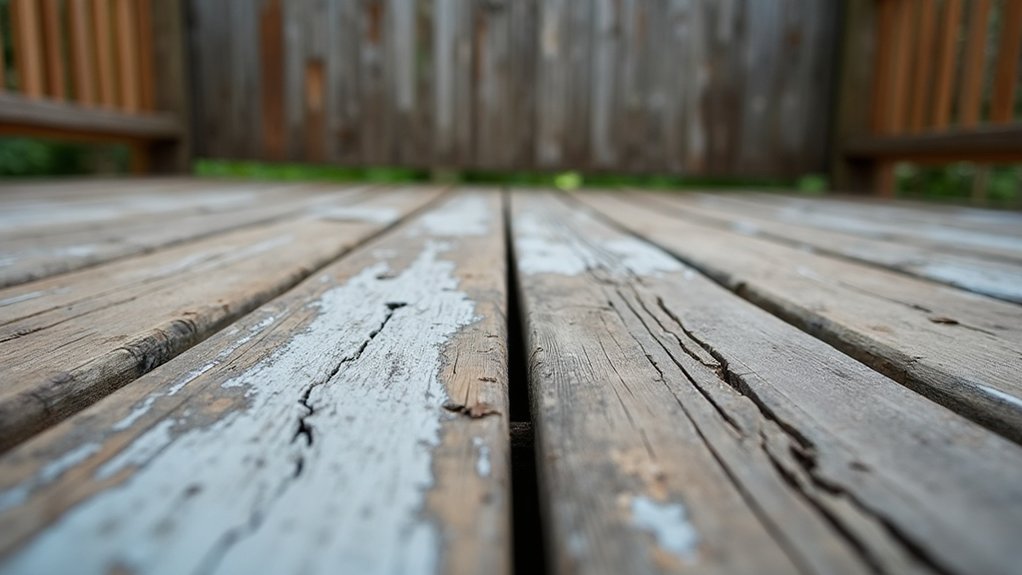As you prepare to paint your deck or fence, it is crucial to understand that regular house paint won’t cut it. The constant exposure to water, sunlight, and foot traffic will cause it to deteriorate rapidly, leading to moisture accumulation, surface chalking, and eventual peeling. You’ll soon find yourself facing a costly and time-consuming repair job. But why do decks and fences require specialized paint formulas, and what makes them so uniquely suited to withstand the harsh outdoor environment?
The Dangers of Using Regular House Paint
When you use regular house paint on your deck or fence, you’re fundamentally setting it up for premature failure. The problem lies in the paint’s formulation, which is designed for vertical surfaces, not horizontal ones that are exposed to the elements.
As a result, the paint can’t withstand the constant barrage of water, sunlight, and foot traffic, leading to moisture accumulation and surface chalking. This means the paint will start to break down, losing its color, texture, and protective qualities.
You’ll notice your deck or fence looking dull, faded, and worn, with paint peeling off in sheets. In extreme cases, this can even lead to wood rot and structural damage. By using the wrong paint, you’re basically inviting these problems into your outdoor space, which can be costly and time-consuming to fix. Unlike regular house paint, specialized formulas offer thick paint coats that act as a weather barrier to protect against rotting, rusting, and sun damage.
Water Repellency: A Key Component
Because deck and fence surfaces are constantly exposed to rain, snow, and dew, water repellency is a critical component of specialized paint formulas. You need a paint that can withstand the elements and prevent moisture absorption, which can lead to warping, cracking, and decay.
A water-repellent paint formula guarantees that water beads up and rolls off the surface, reducing the risk of damage. This is especially important for horizontal deck surfaces, where water can collect and seep into the wood. With a water-repellent paint, you can enjoy improved color retention and a longer lifespan for your deck or fence.
Look for paint formulas that incorporate advanced water-repelling technologies, such as silicone or fluoropolymer additives, to achieve optimal performance and protection. By choosing the right paint, you can safeguard your outdoor structures and maintain their beauty for years to come. Waterproof paint also helps prevent mold growth and structural issues that can compromise the integrity of your deck.
Mildew and Mold Resistance
As deck and fence surfaces remain damp for extended periods, they create an ideal environment for mildew and mold growth. You know that these microorganisms thrive in moist conditions, breaking down organic matter and causing discoloration, rot, and structural damage.
To combat this, you need paint formulas that incorporate mildew- and mold-resistance additives. These additives work by inhibiting the growth of microorganisms, reducing the environmental impact of deck and fence maintenance.
Effective moisture management is indispensable, as it prevents water from seeping into the wood and creating a conducive environment for mildew and mold. By using paints with built-in mildew and mold resistance, you can guarantee your deck and fence remain safe, durable, and aesthetically pleasing for years to come.
UV Protection: Why It Matters
You’ve addressed mildew and mold resistance, but there’s another key factor to ponder: ultraviolet (UV) protection. As you’re selecting a paint formula for your deck or fence, remember that UV rays can cause significant damage. Without proper protection, the color will fade, and the paint will degrade, leading to a worn, weathered appearance.
Temperature resistance is also pivotal, as decks and fences are exposed to extreme temperature fluctuations. A specialized paint formula with UV protection will help preserve the color and integrity of the paint, even in harsh outdoor conditions. Look for formulas that contain UV-absorbing additives, which will help shield the paint from the sun’s harmful rays. By choosing a paint with excellent UV protection, you’ll confirm your deck or fence looks great for years to come.
The Importance of Adhesion
Two critical elements of a paint formula for decks and fences have been addressed so far: mildew and mold resistance, and UV protection.
Now, you’re about to learn why adherence is equally indispensable. When it comes to paint bonding, you want a strong, lasting connection between the paint and the surface. Without it, the paint will peel, flake, or blister, rendering it ineffective.
Surface preparation is key to achieving proper adherence. You must guarantee the surface is clean, dry, and free of contaminants. A specialized paint formula for decks and fences will have additives that promote adherence, such as silanes or siloxanes, which form a strong bond with the substrate. This bond is essential for withstanding the elements and maintaining the paint’s integrity.
Durability in Harsh Weather Conditions
Decks and fences are constantly exposed to harsh weather conditions, including scorching sunlight, torrential rains, and freezing temperatures. You need a paint formula that can withstand these extreme conditions.
Weathering resistance is pivotal to guarantee your deck or fence remains protected and looks great for years to come. A high-quality paint formula will retain its color and sheen even when exposed to intense sunlight, heavy rainfall, or freezing temperatures. Look for formulas with excellent color retention properties to maintain the original color and vibrancy of your deck or fence.
Ensuring Structural Integrity
As the paint formula safeguards your deck or fence from the elements, it’s equally essential that it doesn’t jeopardize the structural soundness of the wood. You want to guarantee the paint you choose doesn’t compromise the load bearing capacity of your deck or fence, especially in areas with high weather exposure.
When wood is exposed to moisture, it can lead to rot, decay, and weakening of the structure. A specialized paint formula can help prevent this by allowing the wood to breathe while maintaining its integrity. Look for paints with breathable coatings that allow moisture to escape, reducing the risk of water accumulation and subsequent damage.
Frequently Asked Questions
Can I Use Deck and Fence Paint on My Outdoor Furniture?
You can use deck and fence paint on outdoor furniture, but guarantee you choose a formula that suits the furniture’s material and consider furniture protection and paint application methods to accomplish a durable, long-lasting finish.
How Long Does Specialized Deck and Fence Paint Typically Last?
You’ll get the most out of specialized deck and fence paint, lasting 5-7 years, if you confirm proper surface preparation and consider weather resistance factors, like UV protection and moisture barriers, to certify a durable, long-lasting finish.
Can I Mix and Match Different Paint Brands for My Project?
When mixing and matching paints, you’ll want to verify paint compatibility by checking the formulations and solvents, as well as considering paint application methods, to avoid compromising adhesion, durability, or color consistency in your deck or fence project.
Do I Need to Sand My Deck or Fence Before Painting?
Before painting your deck or fence, you’ll want to sand it to guarantee a strong bond between the wood and paint, considering penetration depth and facilitating effective moisture management strategies to prevent peeling and cracking.
Can I Use a Roller to Apply Deck and Fence Paint?
When applying deck and fence paint, you’ll want to avoid using a roller, as it can lead to an uneven wet application process. Instead, opt for precise paint application techniques, like brushing or spraying, to guarantee a smooth, consistent finish.

